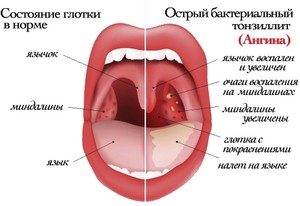
Istoriyu Bolezni Lakunarnaya Angina
Ludwig's angina Synonyms Angina Ludovici Swelling in the area in a person with Ludwig's angina., Symptoms Fever, pain, a raised tongue, trouble swallowing, neck swelling Airway compromise Usual onset Rapid Based on symptoms and examination, Treatment,,, Ludwig's angina is a type of severe involving the floor of the mouth. Early on the floor of the mouth is raised and there is difficulty swallowing saliva, which may run from the person's mouth. As the condition worsens, the airway may be compromised with hardening of the spaces on both sides of the tongue. This condition has a rapid onset over hours.
The majority of cases follow a. Other causes include a,, cut or piercing inside the mouth,. It is a spreading infection of connective tissue through tissue spaces, normally with virulent and invasive organisms. It specifically involves the,,. Prevention is by appropriate dental care including management of dental infections. Initial treatment is generally with. In more advanced cases or may be required.
0.6 0.6 0.6 0.6.
Tekken 5 memory card pcsx2 games. Tekken 5 uses both memory card slots to save game data for either player, but for some reason, i can't get this to work in PCSX2. It wouldn't create player data into slot 2, and only read it when i had manually copied player 1 data into slot 2. All characters, movie and extra costumes are unlocked. Download it from here: SBUSCRIBE, LIKE and SHARE. For Tekken 5 on the PlayStation 2, GameFAQs has 14 save games. Tekken 5 – Save Games PlayStation 2. Arcade Games. PlayStation 2 PS3 Virtual Memory Card. VU Skip for Tekken 5, Limit for Tekken 4. GameFAQ Saves to PCSX2 MemoryCard's. Or download the formatted blank memory cards. Open PS2 Save Builder. Tekken 5 memory card pcsx2 fulltorrent. Tekken 5 pcx2. Tekken 5 pc game portable bittorrent download. Tekken 5 game free download for mac os xtorrent.
With the advent of antibiotics in 1940s, improved oral and dental hygiene, and more aggressive surgical approach, the rates and risk of death among those infected has significantly reduced. It is named after a German physician,, who first described this condition in 1836. Contents • • • • • • • • • • • • • • Signs and symptoms [ ] Ludwig's angina is a form of severe diffuse with bilateral involvement, primarily of the submandibular space with the sublingual and submental spaces also being involved.
It presents with an acute onset and spreads very rapidly meaning early diagnosis and immediate treatment planning is key to saving lives. The external signs may include bilateral lower facial around the mandible and upper neck. Signs inside the mouth may include elevation of the floor of mouth due to sublingual space involvement and posterior displacement of the tongue, creating the potential for a compromised airway. Additional symptoms may include painful neck swelling, tooth pain,, shortness of breath, fever, and general malaise.
Stridor,, and may also be seen when an impending airway crisis is nearing. Cause [ ] The most prevalent cause of Ludwig's angina is odontogenic, accounting for approximately 75% to 90% of cases. Infections of the lower second and third molars are usually implicated due to their roots extending inferiorly below the mylohyoid muscle. Periapical abscesses of these teeth also result in lingual cortical penetration, leading to submandibular infection. However, oral ulcerations, infections of oral malignancy, mandible fracture, bilateral sialolithiasis-related submandibular gland infection, and penetrating injuries of the mouth floor have also been reported as potential causes of Ludwig's angina. In fact, the same microorganisms responsible for less morbid head and neck infections are found in causing extensive infection throughout the floor of mouth and neck when Ludwig's angina is critically reviewed.
Patient with systemic illness, such as diabetes mellitus, malnutrition, compromised immune system, and organ transplantation are also commonly predisposed to Ludwig's angina. It is found that one third of the cases of Ludwig's angina are associated with systemic illness. A review reporting the incidence of illnesses associated with Ludwig angina found that 18% of cases involved diabetes mellitus, 9% involved acquired immune deficiency syndrome, and another 5% were human immunodeficiency virus (HIV) positive. Diagnosis [ ] Infections originating in the roots of teeth can be identified with a. A CT scan of the neck with contrast material is used to identify deep neck space infections.
If there is suspicion of the, a is sometimes done. Angioneurotic oedema, and formation following anticoagulation should be ruled out as possible diagnoses. Microbiology [ ] There are a few methods that can be used for determining the microbiology of Ludwig's angina. One of the traditionally used methods is taking although it has some limitations. By taking pus samples from a patient with Ludwig's angina, the microbiology were found to be commonly polymicrobial. Some of the commonly found microbes are,,,,.
Treatment [ ] For each patient, the treatment plan should be done with consideration of each of the individual patient's differing factors. They are namely the stage of the disease and co-morbid conditions at the time of presentation, physician experience, available resources, and personnel are critical factors in formulation of a treatment plan. There are four principles that guide the treatment of Ludwig's Angina: Sufficient airway management, early and aggressive antibiotic therapy, incision and drainage for any who fail medical management or form localized abscesses, and adequate nutrition and hydration support. Each will be explained in detail below. Airway management [ ]. Placement of an endotracheal tube to aid breathing. Airway management has been found to be the most important factor in treating patients with Ludwig's Angina, i.e.